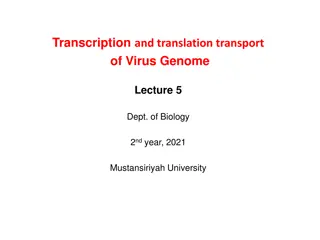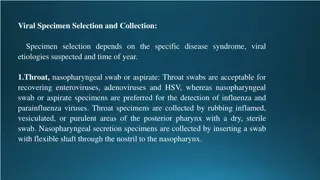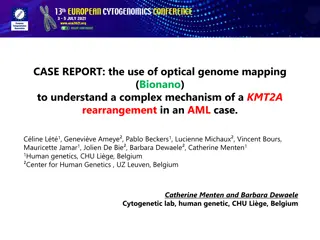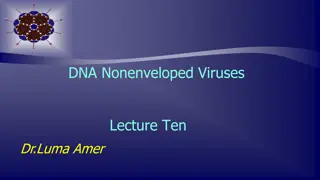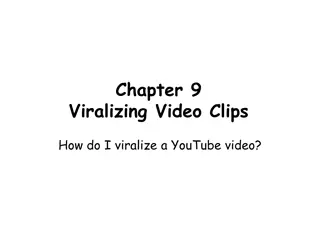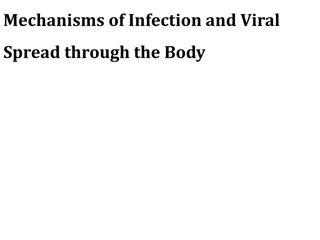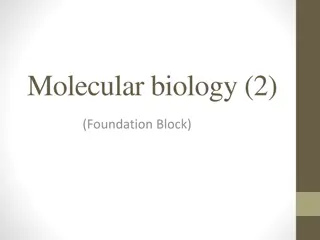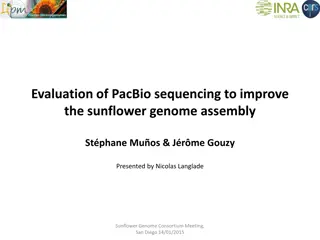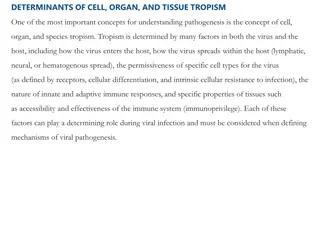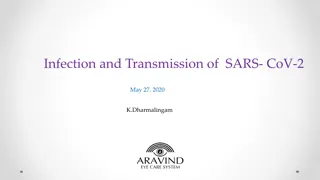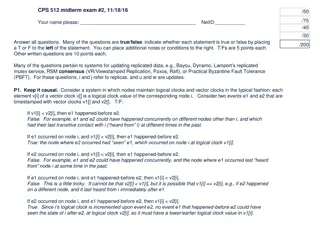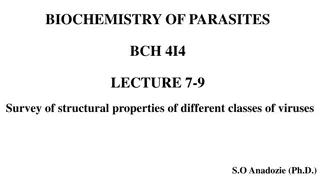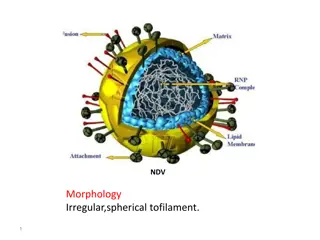Viral Genome Replication Strategies and Mechanisms
Viruses utilize different replication strategies to ensure the replication of viral genomes, packaging into virions, and potentially altering the host cell's structure or function. These strategies are vital for the virus to operate effectively within the host cell's constraints. The replication processes involve conversion of single-stranded DNA into double-stranded form, rolling circle replication, synthesis of complementary strands, and eventual packaging of the viral DNA. Understanding these mechanisms is crucial in studying viral infections and developing targeted treatments.
Download Presentation

Please find below an Image/Link to download the presentation.
The content on the website is provided AS IS for your information and personal use only. It may not be sold, licensed, or shared on other websites without obtaining consent from the author. Download presentation by click this link. If you encounter any issues during the download, it is possible that the publisher has removed the file from their server.
E N D
Presentation Transcript
Replication strategies of viruses DR. IRSHAD UR REMAN
GENERAL Viral genomes contain information which: ensures replication of viral genomes ensures packaging of genomes into virions alters the structure and/or function of the host cell to a greater or lesser degree VIRAL STRATEGY Viral strategy refers to the manner in which each virus carries out the above functions. Since a virus is an intracellular parasite, it has to operate within limits imposed by the host cell, or circumvent these limitations.
DNAVIRUS REPLICATION STRATEGIES General: The virus needs to make mRNAs that can be translated into protein by the host cell translation machinery. The virus needs to replicate its genome. Host enzymes for mRNA synthesis and DNA replication are nuclear and so, if a virus is to avail itself of these enzymes, it needs to enter the nucleus.
Single-Stranded DNA Replication Certain small bacteriophages contain a circular, single-stranded DNA (ssDNA) as genome. Their replication can be divided into three steps 1). Conversion of the ssDNA genome to a double-stranded form, called the replicative form (RF); 2). Multiplication of RF DNA by rolling circle replication; and 3).Generation of ssDNA genome for packaging into phage from the RF DNA.
Conversion of ssDNA into Double-Stranded RF Form Immediately after infection by the ssDNA genome (the plus strand), synthesis of the complementary strand (the minus strand) begins using host enzymes. As all the phage mRNA is synthesized using the minus strand as template strand, no phage messenger RNA is synthesized at this stage. Synthesis of the minus strand is primed using an RNA primer made at a specific site on the plus strand, called minus ori or single-strand ori (sso). Then the host elongation proteins synthesize the minus strand from the primer terminus.
After completion of the minus-strand synthesis, the initial product is a duplex circular DNA (RFII) consisting of an intact viral DNA and a nearly full-length linear complementary DNA plus the RNA primer. Then DNA polymerase removes the RNA primer and fills the resultant gap. Subsequently, the nick is sealed by DNA Ligase, and the duplex DNA is converted to the superhelical form (RFI).
Rolling Circle Replication of RF DNA Multiplication of RF DNA is initiated by introducing a nick by an initiator nuclease encoded in the phage genome at a particular site in the plus strand (plus ori or double-strand ori, dso) (step 4 in Fig. 1). The free 3 -OH end at the nick site serves as a primer and is elongated by DNA polymerase III holoenzyme, as the host Rep DNA helicase peels off the existing plus strand.
When synthesis of the new plus strand reaches the plus ori (step 6 in Fig. 1), the nick is introduced again at the junction of the old and newly synthesized plus strand, to form linear ssDNA of one unit length (step 7 in Fig.1). The linear form is then converted into the circular form, a further reaction catalyzed by the initiator nuclease. Thus, one round of the rolling circular replication produces one new plus strand, and it is used as a template to form another RF DNA.
dsDNA rolling circle replication Related to Most nuclear dsDNA viruses, and many phages. Location: In host cell nucleus (eukaryotes) or cytoplasm (prokaryotes). Replication events: This kind of replication is used by many dsDNA viruses. DNA replication begins at specific locations in the genome, called origins . A viral endonuclease creates a nick in the origin of replication. The replication machinery assembles with the DNA polymerase on the 3 extremity.
The DNA polymerase and associated factors begins to proceed to a strand displacement synthesis, producing a concatemer linear single stranded DNA with one genome copy per turn of replication. On the concatemer strand, Okazaki fragments are elongated after sequencial RNA primer synthesis by the primase, thus turning it into dsDNA. The concatemer strand RNA primer are removed and okazaki fragments ligated. The replication forks go on and produces a long linear concatemer which will be processed into linear genomes and encapsidated.
Positive stranded RNAvirus replication After entering the host cell, the virion uncoats in the cytoplasm, releasing the positive, single-stranded RNA. Since the positive RNA strand is already in the form of messenger RNA, it can be translated immediately into capsomere proteins used to assemble new viral capsids. Replication of the positive RNA strand is accomplished in two steps. First, through complementary base pairing, RNA polymerase creates a template strand. Second, the template strand is used to make many complementary positive RNA strands. The newly made positive strands combine with the capsids to complete the construction of new positive, single-stranded RNA virions.
Negative stranded RNAvirus replication Single-stranded RNA viruses contain either a positive RNA strand or a negative RNA strand. After entering the host cell, the virion uncoats in the cytoplasm, releasing the negative, single-stranded RNA. Unlike positive, single-stranded RNA, the negative stranded RNA is not in the form of messenger RNA. So RNA polymerase must first make template strands through complementary base pairing. These template strands, which are in the form of messenger RNA, can now be translated into capsomere proteins used to assemble new viral capsids. The template strands are also used to produce new negative RNA strands. The newly made negative RNA strands combine with the capsids to complete the construction of new, negative stranded RNAvirions.







